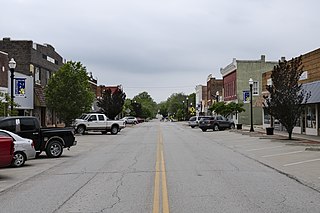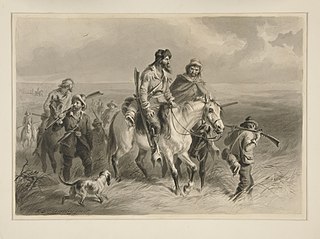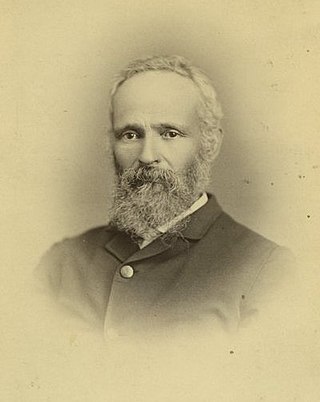
John Brown was a prominent leader in the American abolitionist movement in the decades preceding the Civil War. First reaching national prominence in the 1850s for his radical abolitionism and fighting in Bleeding Kansas, Brown was captured, tried, and executed by the Commonwealth of Virginia for a raid and incitement of a slave rebellion at Harpers Ferry in 1859.

Osawatomie is a city in Miami County, Kansas, United States, 61 miles (98 km) southwest of Kansas City. As of the 2020 census, the population of the city was 4,255. It derives its name as a portmanteau of two nearby streams, the Marais des Cygnes River and Pottawatomie Creek.

Bleeding Kansas, Bloody Kansas, or the Border War was a series of violent civil confrontations in Kansas Territory, and to a lesser extent in western Missouri, between 1854 and 1859. It emerged from a political and ideological debate over the legality of slavery in the proposed state of Kansas.

Border ruffians were proslavery raiders who crossed into the Kansas Territory from Missouri during the mid-19th century to help ensure the territory entered the United States as a slave state. Their activities formed a major part of a series of violent civil confrontations known as "Bleeding Kansas", which peaked from 1854 to 1858. Crimes committed by border ruffians included electoral fraud, intimidation, assault, property damage and murder; many border ruffians took pride in their reputation as criminals. After the outbreak of the American Civil War in 1861, many border ruffians fought on the side of the Confederate States of America as irregular bushwhackers.
The Pottawatomie massacre occurred on the night of May 24–25, 1856, in the Kansas Territory, United States. In reaction to the sacking of Lawrence by pro-slavery forces on May 21, and the telegraphed news of the severe attack on Massachusetts Senator Charles Sumner, John Brown and a band of abolitionist settlers—some of them members of the Pottawatomie Rifles—responded violently. Just north of Pottawatomie Creek, in Franklin County, they killed five pro-slavery settlers in front of their families.
The Pottawatomie Rifles was a group of about one hundred abolitionist settlers of Franklin and Anderson County, Kansas, both of which are along Pottawatomie Creek. The band was formed in the fall of 1855, during the Bleeding Kansas period, as an armed militia to counter growing pro-slavery presence: an influx of men known as border ruffians, from the neighboring slave state of Missouri.

The Marais des Cygnes massacre is considered the last significant act of violence in Bleeding Kansas prior to the outbreak of the American Civil War. On May 19, 1858, approximately 30 men led by Charles Hamilton, a Georgia native and proslavery leader, crossed into the Kansas Territory from Missouri. They arrived at Trading Post, Kansas, in the morning and then headed back to Missouri. Along the way, they captured 11 Free-Staters, none of whom were armed and, it is said, none of whom had participated in the ongoing violence. Most of the men knew Hamilton and apparently did not realize he meant them harm. These prisoners were led into a defile, where Hamilton ordered his men to shoot, firing the first and last bullet himself. Five men were killed and five severely wounded. Only one Free-Stater escaped injury.
Marais des Cygnes may refer to:

The Battle of Black Jack took place on June 2, 1856, when antislavery forces, led by the noted abolitionist John Brown, attacked the encampment of Henry C. Pate near Baldwin City, Kansas. The battle is cited as one incident of "Bleeding Kansas" and a contributing factor leading up to the American Civil War of 1861 to 1865.

At the outbreak of the American Civil War in April 1861, Kansas was the newest U.S. state, admitted just months earlier in January. The state had formally rejected slavery by popular vote and vowed to fight on the side of the Union, though ideological divisions with neighboring Missouri, a slave state, had led to violent conflict in previous years and persisted for the duration of the war.

Trading Post is an unincorporated community in Linn County, Kansas, United States.
The Battle of Osawatomie was an armed engagement that occurred on August 30, 1856, when 250–400 pro-slavery Border ruffians, led by John W. Reid, attacked the town of Osawatomie, Kansas, which had been settled largely by anti-slavery Free-Staters. Reid was intent on destroying the Free-State settlement and then moving on to Topeka and Lawrence to do more of the same. Abolitionist John Brown first learned of the raiders when they shot his son Frederick. With just 40 or so men, Brown tried to defend the town against the pro-slavery partisans, but ultimately was forced to withdraw; five Free-Staters were killed in the battle, and the town of Osawatomie was subsequently looted and burned by Reid's men. The battle was one of a series of violent clashes between abolitionists and pro-slavery partisans in Kansas and Missouri during the Bleeding Kansas era.
The timeline of Kansas details past events that happened in what is present day Kansas. Located on the eastern edge of the Great Plains, the U.S. state of Kansas was the home of sedentary agrarian and hunter-gatherer Native American societies, many of whom hunted American bison. The region first appears in western history in the 16th century at the time of the Spanish conquest of the Aztec Empire, when Spanish conquistadors explored the unknown land now known as Kansas. It was later explored by French fur trappers who traded with the Native Americans. It became part of the United States in the Louisiana Purchase of 1803. In the 19th century, the first American explorers designated the area as the "Great American Desert."

Lecompton Constitution Hall, also known as Constitution Hall, is a building in Lecompton, Kansas, that played an important role in the long-running Bleeding Kansas crisis over slavery in Kansas. It is operated by the Kansas Historical Society as Constitution Hall State Historic Site.

The John Brown Museum, also known as the John Brown Museum State Historic Site and John Brown Cabin, is located in Osawatomie, Kansas. The site is operated by the Kansas Historical Society, and includes the log cabin of Reverend Samuel Adair and his wife, Florella, who was the half-sister of the abolitionist John Brown. Brown lived in the cabin during the twenty months he spent in Kansas and conducted many of his abolitionist activities from there. The museum's displays tell the story of John Brown, the Adairs and local abolitionists, and include the original cabin, Adair family furnishings and belongings, and Civil War artifacts.

There are eight properties listed on the National Register of Historic Places (NRHP) in Linn County, Kansas. Two of the sites are the location of historic events. The Marais des Cygnes Massacre Site is the location of the Marais des Cygnes massacre, an 1858 event during Bleeding Kansas in which pro-slavery advocates kidnapped 11 anti-slavery settlers, killing five of them. John Brown temporarily used the site as a fort, and the property was listed on the NRHP in 1971. The Battle of Mine Creek Site preserves the location of the Battle of Mine Creek, which was fought in 1864 as part of Price's Raid during the American Civil War. Confederate general Sterling Price's army was retreating after being defeated at the Battle of Westport and was attacked by pursuing Union troops. Price's Confederate lost heavily in men and supplies. The site was added to the NRHP in 1973.

August Bondi was an Austrian-American Jew involved in the Border War and later the American Civil War. In Kansas, he was a part of the Pottawatomie Rifles and fought alongside abolitionists John Brown and James Lane.














